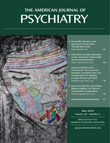To the Editor: We appreciate Ms. Keating's comments on our study that showed differential activation in the ventral striatum upon processing of underweight and normal weight disease-specific stimuli in women with anorexia nervosa and healthy comparison women.
Ms. Keating assumes that our disease-specific stimulation should have been accompanied by cognitive processing and hence should have activated cognitive cortices that the region-of-interest-based approach might have missed. Furthermore, acute and recovered states of anorexia nervosa may be accompanied by different processing of any type of disease-related or unrelated stimulation and may therefore limit the interpretation of our results.
The region-of-interest-based approach was chosen due to strong evidence for the involvement of the ventral striatum in the mediation of starvation dependence. Beyond the region-of-interest analysis, we also reported on a whole-brain analysis that tested the group-by-stimulus interaction of interest but did not reveal any further brain regions (p. 210). The lack of effects in cognitive cortices is in contrast to a previous study on anorexia nervosa that showed, with disease unrelated rewards, increased activation in prefrontal and parietal regions (
1). It may be this difference in stimulus material that explains the discrepancy among observations. Possible further influences of different states of illness and recovery are an interesting point. The presence of symptoms in children at risk for anorexia nervosa and in recovered patients has led to the concept of enduring trait variables that are present in both acute and recovered states (
1,
2). Thus, even when patients have recovered, usually defined by a changed status of malnutrition, enduring trait-related alterations, such as altered dopamine function or increased drive for thinness, do persist. We strongly agree that possible alterations of these variables and corresponding neural processes should be tracked in longitudinal studies, which we mentioned in our article (p. 211).
Regarding the within-group differences in the magnitude of activation between stimulus sets, we would like to stress that the main result of our study was in fact the highly significant between-group difference of the variation of neural magnitudes upon processing of underweight and normal weight stimuli (i.e., the group-by-stimulus interaction). Within groups, we computed the percentages of ventral striatal voxels with significant differential activity upon processing of underweight versus normal weight stimuli at a threshold of at least p<0.05. It was the different percentage of voxels that we interpreted as a putative qualitative feature differentiating between healthy comparison women and women with anorexia nervosa. Insight into the rewarding or aversive aspects of the stimuli beyond the subjective ratings during the feel task could certainly have further informed the interpretation of this difference.
Whether the contrast of neural activities in the weight task versus the self-referent feel task could have revealed regions involved in dysmorphic self-assessments was not further tested. The random sequence of both task instructions could have resulted in a spillover effect that would not have been ideal to compute unbiased comparisons. This is supported by the fact that in the weight task alone the group-by-stimulus interaction was already significant, although of lower size relative to the feel task (see the data supplement accompanying the online version of the article).

